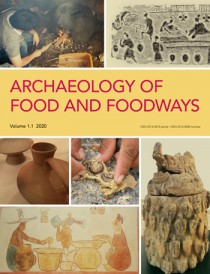Pastoral Dairying in Rural Mongolia
Microbes as Heritage
DOI:
https://doi.org/10.1558/aff.15577Keywords:
Dairy, Pastoralism, Mongolia, Starter Cultures, Microbes, HeritageAbstract
In this photo essay, I illustrate ethnographic encounters with dairying practices and dairy microbes in various regions of Mongolia. Drawing on fieldwork conducted during two consecutive summers, this essay focuses on the sociocultural role of microbial starter cultures in producing diverse dairy products (such as fermented mare’s milk) and in cross-generational knowledge transfer. The Mongolian word for starter culture is khöröngö, which also means capital and heritage. In this context, a sociocultural anthropological approach sheds new light on starter cultures as mobile entities of value across space and time.
References
Archie, E. A. and Theis, K. R. 2011. “Animal Behaviour Meets Microbial Ecology” Animal Behaviour 82(3): 425–436. https://doi.org/10.1016/j.anbehav.2011.05.029
Empson, R. 2011. Harnessing Fortune: Personhood, Memory and Place in Mongolia. Oxord: Oxford University Press. https://doi.org/10.5871/bacad/9780197264737.001.0001
Enkhtsetseg, E., Odonchimeg, B., Gantogtokh, G., Batsukh, Ts. and Ya. Altantsetseg. 2015. (Mongol Nüüdelchdiin Tailbar Tol‘ II – Explanatory Dictionary of Mongolian Nomads II). edited by G. Suld-Erdene. Ulaanbaatar: Monsudar.
Fijn, N. 2011. Living with Herds: Human-Animal Co-Existence in Mongolia. Cambridge: Cambridge University Press.
Fuller, D. Q. and Rowlands, M. 2011. “Ingestion and Food Technologies: Maintaining Differences over Long-term in West, South, and East Asia” In Interweaving Worlds: Systemic Interactions in Eurasia, 7th to the 1st Millennia BC. edited by Toby C. Wilkinson, Susan Sherratt and John Benett. 37–60. Oxford: Oxbow Books. https://doi.org/10.2307/j.ctvh1dr2k.9
Honeychurch, W. and Makarewicz, C. A. 2016. “The Archaeology of Pastoral Nomadism” Annual Review of Anthropology 45: 341–359. https://doi.org/10.1146/annurev-anthro-102215-095827
Humphrey, C. 1992. “Women and Ideology in Hierarchical Societies in East Asia” In Persons and Powers of Women in Diverse Cultures. Essays in Commemoration of Audrey I. Richards, Phyllis Kaberry and Barbara E. Ward. edited by Shirley Ardner. 173–192. New York: Berg.
Jeong, Ch., Wilkin, S. and Tsend Amgalantugs et al. 2018. “Bronze Age Population Dynamics and the Rise of Dairy Pastoralism on the Eastern Eurasian steppe” In Proceedings of the National Academy of Sciences (PNAS) USA. https://doi.org/10.1073/pnas.1813608115
Lonjid, Z. and Erdenebat, D. (n.d). “(XIII–XIX) (Mongolian Politics, and Milk and Dairy Products (13th to 19th century))” Studia Ethnologica XXV: 28–43. (accessed through https://www.academia.edu/41655851/ on 9th May, 2020)
Luvsanjav, Ch. 1980. “Milk in the Mongol Customs: Some Remarks on Its Symbolic Significance” Etnografia Polska 24(1): 41–43.
O’Gorman, K. D. and Thompson, K. 2007. “Mongolian hospitality: Intrepid Travelling” Hospitality Review 9(3): 19–27.
Ruhlmann, S. 2019. Inviting Happiness: Food Sharing in Post-Communist Mongolia. Leiden: Brill. https://doi.org/10.1163/9789004410633
Tamime, A. 2002. “Microbiology of Starter Cultures” In Dairy Microbiology Handbook: The Microbiology of Milk and Milk Products. edited by Richard K. Robinson. 261–366. New York: Wiley Interscience. https://doi.org/10.1002/0471723959.ch7
Taylor, W., Wilkin, S., Wright, J., Dee, M., Erdene, M., Clark, J., Tuvshinjargal, T., Bayarsaikhan, J., Fitzhugh, W. and Boivin, N. 2019. “Radiocarbon Dating and Cultural Dynamics Across Mongolia’s Early Pastoral Transition” PLoS ONE 14(11): e0224241. https://doi.org/10.1371/journal.pone.0224241
Taylor, W.T.T., Clark, J., Bayarsaikhan, J. et al. 2020. “Early Pastoral Economies and Herding Transitions in Eastern Eurasia” Scientific Reports 10: 1001. https://doi.org/10.1038/s41598-020-57735-y
Thrift, E. 2014. “‘Pure milk’: Dairy Production and the Discourse of Purity in Mongolia” Asian Ethnicity 15(4): 492–513. https://doi.org/10.1080/14631369.2014.939332
Warinner, C., Hendy, J., Speller, C. et al. 2014. “Direct Evidence of Milk Consumption from Ancient Human Dental Calculus” Scientific Reports 4: 7104. https://doi.org/10.1038/srep07104
Wilkin, S., Ventresca Miller, A., Taylor, W.T.T. et al. 2020. “Dairy Pastoralism Sustained Eastern Eurasian Steppe Populations for 5,000 years” Nature, Ecology & Evolution 4: 346–355. https://doi.org/10.1038/s41559-020-1120-y
Wright, J. 2016. “Households without Houses: Mobility and Moorings on the Eurasian Steppe” Journal of Anthropological Research 72(2): 133–157. https://doi.org/10.1086/686297
Zhang, W., Yu, D., Sun, Z., Wu, R., Chen, X., Chen, W., Meng, H., Hu, S. and Zhang, H. 2010. “Complete Genome Sequence of Lactobacillus casei Zhang, a New Probiotic Strain Isolated from Traditional Homemade Koumiss in Inner Mongolia, China” Journal of Bacteriology 192(19): 5268–5269. https://doi.org/10.1128/JB.00802-10
Zimmermann, A. E. 2010. Raumkonzepte, soziale Organisation und Übergangsriten in der heutigen Mongolei. Wiesbaden: Harrassowitz.
Online References
UNESCO. 2019. Traditional technique of making Airag in Khokhuur and its associated customs. https://ich.unesco.org/en/RL/traditional-technique-of-making-airag-in-khokhuur-and-its-associated-customs-01172 last accessed December 16, 2019.





